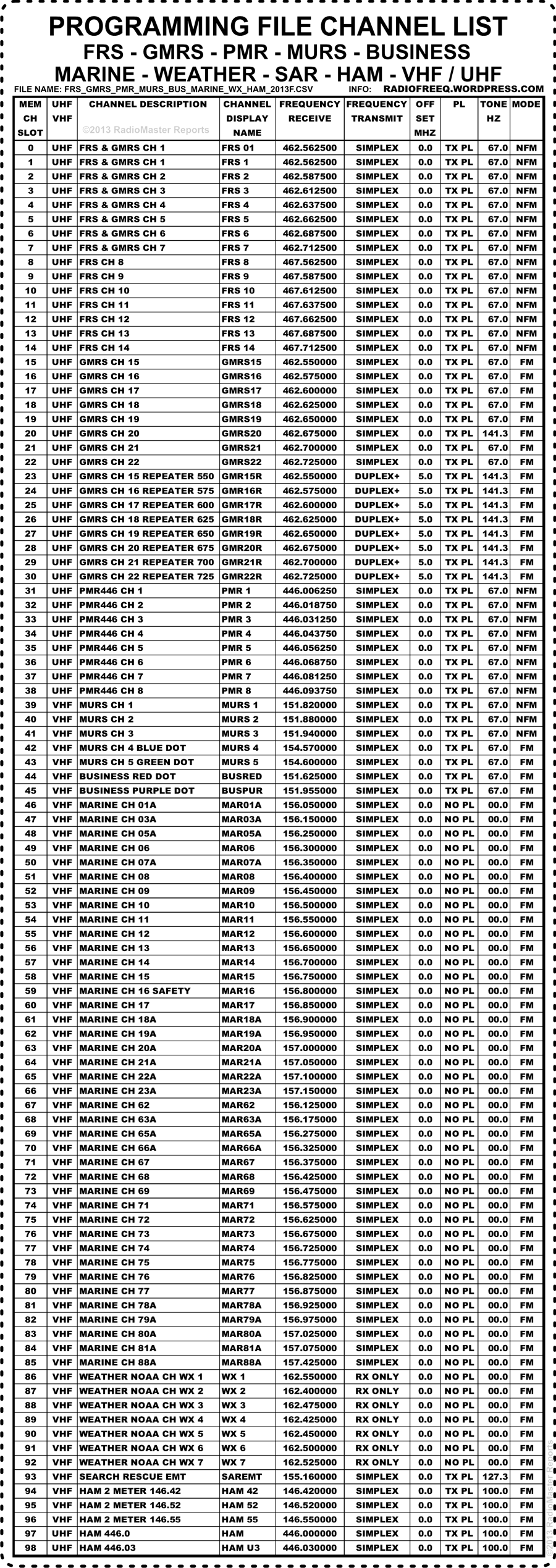Update FRS_GMRS_PMR_MURS_BUS_MARINE_WX_HAM_2013E.csv
An updated CSV file is available for download.
File name:
FRS_GMRS_PMR_MURS_BUS_MARINE_WX_HAM_2013E.csv
Printable Chart
Many thanks to those who have pointed out errors in the printed chart and given feedback, on things like NFM vs FM on some channels. The file has been updated, and some notes from the original article have been pasted here for clarity.
Here are some notes from the
main article about this release:
LIMITATIONS
The design objective of this programming file is to maximize interoperability with common radio services in less than 99 channels, in order that it can be used within the memory limitations of inexpensive radios. This has led to a small compromise somewhat, by not including some less common business itinerant channels and marine duplex radiotelephone channels. An additional larger channel list programming file will be posted on the
RadioMaster Reports site for download, when updated later.
GMRS
General Mobile Radio Service (GMRS) is a local distance radio system in the same UHF band as FRS. GMRS radios can be capable of longer distance range and greater dependability than FRS. GMRS is becoming more popular as bubble pack walkie talkies (HT) include both GMRS and FRS channels. GMRS-specific frequencies are FM simplex or duplex with 8 channels at 462 MHz and 8 channels at 467 MHz in the UHF band. The maximum power level of a GMRS is limited to 50 Watts. The most common GMRS mobile, base, or repeater radios use external gain antennas. GMRS walkie talkie handheld transceivers (HT) have only 5 Watts or less, commonly with a ducky antenna. Full duplex repeaters can be used with GMRS. GMRS Repeaters have their input channel at 467 MHz, and their output at 462 MHz. The offset is exactly 5 MHz. For repeater use, the field units transmit on 467 Mhz and receive on 462 MHz. Most bubble pack GMRS radios are simplex-only, so they do not function through a repeater. They operate only on the repeater output frequency (GMRS Channels 15 through 22). In a GMRS radio, the GMRS channel number is often the same for simplex and duplex, but a secondary (programmable) feature of the channel controls whether it transmits duplex +5MHz split or simplex. The GMRS simplex and duplex (repeater) channels are included in this list and programming file. In the Channel Name, they are programmed and identified separately; the repeater channel has an R in the channel name. For example as GMR 20 is the simplex channel, and GMR20R is the repeater duplex channel. PL tones vary among different repeaters in various geographic areas. The default PL tone for GMRS is 141.3 Hz, but it can be changed in the user’s radio programming to another PL tone frequency as required to hit specific repeaters.
PMR446
Personal Mobile Radio (PMR or PMR446) is a low power, short range, radio system similar to FRS. It is very common in Europe, Africa, and Asia. Walkie talkie bubble pack PMR radios are sold cheaply. PMR radios are limited to a half-watt of output power (500 milliWatts). So, the normal range of PMR walkie talkies in a suburban environment is about a mile or less. PMR frequencies are commonly FM simplex, 8 channels at 446 MHz in the UHF band. An additional 14 digital channels are available for PMR446, but are less common. In USA and many other places, the 446 MHz band is assigned to Amateur Radio Service (Ham) so, all the PMR channels and radios can be used by hams in those areas. The PMR Prepper channel (PMR 3) (446.03125 MHz) is somewhat interoperable with the Ham UHF Prepper channel (HAM U3) (446.030 MHz).
HAM
Amateur Radio Service, widely known as Ham Radio, is an internationally allocated radio service for non-commercial radio communications. It has frequency bands in all areas of the spectrum. The ham radio frequencies in this list are only a few of the most common VHF and UHF channels used by ham operators for local FM simplex. Additionally the list includes the Prepper Ham VHF simplex channel (146.420 MHz), the Survivalist Ham VHF simplex channel (144.550 MHz) and the Prepper Ham UHF simplex channel (446.030 MHz) that is somewhat interoperable with the PMR Prepper channel 3 (446.03125 MHz). Most hams also make use of repeaters in the VHF and UHF bands, but the channels for these repeaters vary according to geographic area. There is no common repeater channel frequency or PL tone that is valid in all areas, they are all different. When programming your radio, it is advisable to include the repeater channels and PL tones in your area. See a repeater directory for more information.
PL TONE
All channels are default to Receive Carrier Squelch. All FRS, GMRS, PMR, MURS, BUSINESS, and HAM channels are programmed in the file transmitting the most common default PL tone frequencies but receiving Carrier Squelch, for maximum interoperability. The Marine channels have the transmit PL tone turned off, and use Receive Carrier Squelch. The user may change and reprogram the PL Tone frequency as needed, or may desire to use Tone Squelch instead of Carrier Squelch.
-RadioFreeq
RadioMaster Blog
"
Survivalist Communications for the SHTF Prepper"





